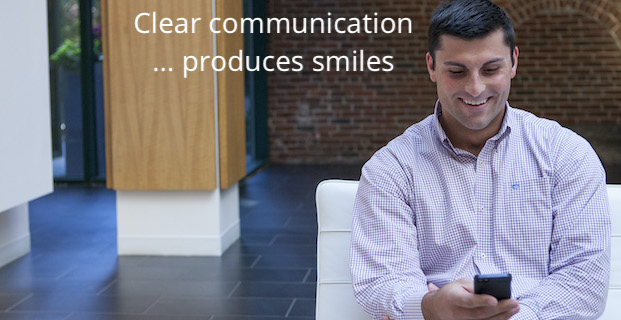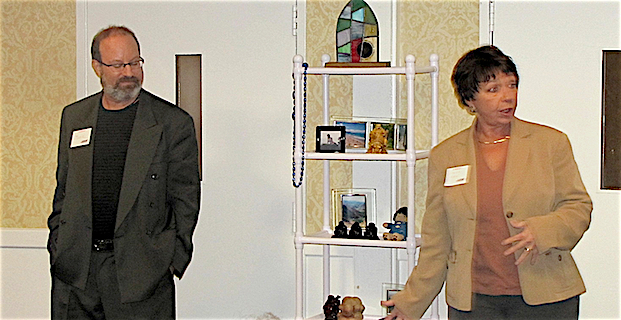by Mark Bloom | Jan 21, 2020 | Communication
Business Owners Especially Benefit from Clarity

The world of economics is driven by individual ambitions, group dynamics and national goals. But you could also say something similar about the world of personal relationships. The thing that bridges the gap between these widely diverse realms is communication.
When human beings are involved, clear communication is good for everyone involved. It doesn’t matter whether you’re an economics professor giving a high-level lecture or a love-smitten individual courting a partner. When you can impart information in a way that promotes understanding and action, you enable positive results, regardless of your specific goals.
Businesses Have Many Audiences
Personal relationships aside — since that topic would require a hundred blog posts written by a certified therapist — clear communication benefits your business in many ways because you serve several and likely very diverse audiences, such as your:
- Clients or customers
- Internal teams and employees
- Vendors and suppliers
- Third-party contractors — such as content writers, web designers, user experience experts and SEO firms
- Media contacts
- Investors
Each of these groups requires specific information from you. The better you can deliver clear communication, the easier your professional relationships become to manage. And that makes managing your business easier.
How to Improve Your Communications
Regardless what your business entails, you can learn to improve your communication skills. It takes commitment and desire, but you can will yourself to more clearly impart your meaning to whomever you’re trying to reach. Practice techniques that include:
- Listening. Clear communication begins by listening to your audience. They may tell you what they want and what’s important to them. Communication is a two-way process. You can’t effectively reach someone until you’ve listened to their needs and concerns.
- Learning all you can about your intended audience. Find out who they are and what they want from you or your business. Learn their language — slang, acronyms and all — and use it freely when appropriate. The most useful information becomes useless if your audience doesn’t understand what you’re trying to say.
- Making it easy for your audience to understand. People learn in different ways. Some learn by listening. Others learn by hearing. Still others have to get hands-on to learn. Tailor your delivery to give as many learning options as possible to satisfy the highest number of your intended audience.
- Understanding why your message matters to your audience. Know your goals in communicating. Are you trying to encourage action? Do you want to educate? What’s the urgency of your message? You should be able to answer these questions without hesitation. That knowledge gives your message the gravitas it needs to hit its target.
- Simplifying your message. Everyone in business has to manage hundreds of daily emails and battle a constant flow of spam. Your business communications aren’t a literary short story, so don’t make your readers wait. Get right to the point and deliver your message in the simplest of ways. Simplify your language, deliver it in a way that connects and ask for confirmation.
- Determining the emotional impact of your message. If what you’re imparting has an emotional component, consider delivering it in person. Don’t discharge an employee by email, text or phone message. Do it in person. Even positive news is more effective coming directly from you.
- Putting it in writing if you need to make sure they got it. The more complex the information, the more important it is that you give it to your audience in writing. They may need to refer back to your message. If your message is important enough, deliver written clear communication so they have it when they need it.
Ray Access is a content marketing firm that delivers targeted words to empower your business to succeed. Contact us about your specific project to receive a quote. We write website copy, blog posts, e-newsletters, and more. Everything we do is thoroughly researched, professionally edited and guaranteed original.
by Mark Bloom | Jul 31, 2018 | Communication
A Nonpolitical Look at Language and Learning

Fake news is apparently everywhere. On television. In print. Online. You can’t help but trip over it every day, no matter where you get your news. It has invaded our culture and perverted our political system.
At Ray Access, we’re not interested in writing about politics, but we are passionate about language. So, these questions kept popping up: What is fake news, really? How do you define it? According to the Cambridge Dictionary, fake news is:
“False stories that appear to be news, spread on the internet or using other media, usually created to influence political views.”
In other words, fake news is propaganda, which the same dictionary defines this way:
“Information or ideas that are spread by an organized group or government to influence people’s opinions, especially by not giving all the facts or by secretly emphasizing only one way of looking at the facts.”
Definitions, Please
The reason the term fake news has caught on — or gone viral, as the saying goes — is that it’s succinct and catchy. It’s just two common words, but two words that until recently were never joined together. Everyone, even a child, understands what fake means. And most adults realize that news is more than an acronym for North, East, West and South. So, let’s examine each word for its meaning:
- Fake. Not the real thing, an imposter or substitute. Margarine is fake butter. Naugahyde is fake leather. Cubic zirconia is a fake diamond. Of course, these examples can be proven fake fairly easily.
- News. Information published or delivered as meaningful and relevant. The weather is news, although you could successfully argue that tomorrow’s weather is mere speculation. Sports scores are news, as is current traffic and this week’s lottery numbers. News is, by definition, a report of past or current facts.
Putting the Ache in Fake News
When considering the term fake news, based on the definitions above, you may think it contains facts that aren’t real. But real news is a reporting of something that’s already happened. The games are over, and the scores are in. No one disputes that. The stock market rose or fell by a certain percentage. It’s the same number regardless where you look. Doesn’t that make it real?
The issue that the term fake news raises — which is both brilliant and chilling — is not the reporting of facts, but the interpretation of those facts. Is it fake news to declare that the stock market rose or fell because a popular sports team won or lost? Suddenly, the cause-and-effect logic of reality skips a beat, and anything seems not only possible, but probable.

What’s in a Report?
Fake news also plays on people’s base fears that the media or the government can’t be trusted. If you buy a dozen eggs, and one turns out to be bad, you may not want to try the other 11. If you visit a distant city that seems just like your hometown, suddenly every city is the same, and it doesn’t matter where you live. Similarly, if you pick out one quote from a newscast that is proven false, you no longer believe anything on that channel.
Additionally, while the definition of fake has stayed relatively stable over the years, the term news has morphed again and again. Today, celebrity gossip is delivered as news. News isn’t just what a person said, which is all that actually is real, but what he meant by it, which is pure speculation. Today’s news has a spin, and it may be classified as fake if it spins away from the direction you lean.
Stopping Fake News
The simplest way to stop fake news is to question the term itself. When a report is labelled with that phrase, ignore the words and ask questions to determine what about it is fake and what about it is news. You may learn that it’s fake, but it’s not really news, as this article defines it. You may learn that it’s not fake and it’s not even news. Whatever you learn, you’ll have learned more than if you had simply accepted the label.
The more complex way to stop news that’s fake is not by shutting down newspapers or censuring speech. There may always be lies, just as there may always be poverty, crime or taxes. The way to ultimately stop fake news is not to shut the mouth that speaks, but to change the eye that sees and the ear that hears. Learn to discern facts from speculation. Learn to be wary until facts emerge.
A Transferable Skill
What does this topic have to do with a small business that writes website content and blog posts? Why write about fake news at all? It’s simple, really: media literacy is a transferrable skill. Media literacy is the ability to comprehend what a news report is really saying. If you can learn to tell real news from fake news, you’ve become not just a better citizen, but a smarter consumer as well.
Media literacy is a skill not many people cultivate today, but it’s a skill that benefits you every day, especially online. When you’ve read as many websites as the team at Ray Access has, you get a sense of what’s real and what’s fake. Is a promise genuine or an attempt to sell you something? When you can determine the answer to that, you won’t need anyone else telling you what’s real and what’s fake news.
Ray Access is a content marketing firm that delivers targeted words to empower your business. Contact us about your specific project to receive a quote or discuss your needs. We write website copy, blog posts, e-newsletters and more. Everything we do is thoroughly researched, professionally edited and guaranteed original.
by Elle Ray | Oct 3, 2017 | Communication
The Importance of Communication to Business
The words you say — and the way you say them — may change over time. The devices you use to send those messages get smaller and smaller every year. And the voice delivering the statements may not even be your own, but something artificial. But no matter who, what, where or how your message is delivered, the importance of communication never goes out of style.
People grapple with generational differences. It may be Baby Boomers versus Millennials in a race to see who’s going to be coolest. Or perhaps it’s Gen Xers trying to outdo Depression-era elders in a pitch for relevance. More and more, competing voices from different ages may not use the same slang, but they may actually be saying the very same thing — and yet they can still end up arguing over who’s right and who’s wrong.

Communication is vital for society, and yet it changes all the time. Every new generation comes up with its own accepted words: “groovy,” “cool,” “bad” or “killa,” just to name a few. If you own or run a business, it means you have to take into consideration the culture of your target audiences — all of them. It just may be time to brush up on the trendy parlance while ditching your old vernacular, especially if you intend on reaching all the available markets.
The Importance of Communication in Business
It’s one thing to have a communication gap within the ranks of your company. You can always hold in-house workshops to help the various generations learn how to speak to one another, or let them duke it out (metaphorically, of course) in your dining hall or HR offices. And while the importance of communication can’t be overstated for smoothing your internal operations, you won’t have any internal operations to worry about if you don’t bridge that gap with your customers and potential customers.
If the first step in overcoming a bad habit is to admit you have a problem, then the first step in updating your marketing message is to realize that maybe your message isn’t hitting all the targets you’d planned to hit. The importance of communication in your marketing message can’t be all things to all people. You have to keep an open mind and be willing to admit that maybe you don’t have all the answers. Maybe, just maybe, you are wrong sometimes!
The Fix Is In
You may believe that to reach all the generations, all you have to do is to cover all the delivery bases. So you put your marketing message out in the local newspaper, in industry magazines, on your website and through a ton of social media platforms. Covered? Not quite. You also must be sure that your message is clear and understood by everyone who receives it.
Take a look at few examples that show how a simple word or phrase can be taken so differently by diverse generations:
- “Are you going social today?” If you ask a younger client, she may think you’re asking if she’s spending time on Twitter, while if you ask your older readers, they may think you want to meet them at a dance party.
- When an older person says, “Sure,” she means “OK.” Younger people, though, use the same word when they’re not paying attention.
- “Special” used to mean precious and uncommon. Now it’s basically a euphemism for someone with a mental handicap.
These just show a few tips of the icebergs floating in the treacherous waters of mindless communication. That’s why the importance of communication — actually reaching your target audience — is the key to marketing. Bad or miscommunication can break your marketing campaign if you’re not careful. And there are plenty of examples that are far worse, such as believing that all you need to do is get the syntax right and your true intentions become abundantly clear.
The Fix Is Not In
You know what happens when you assume something. It almost always ends poorly. And that’s what happens when you assume that everyone in your target group speaks the same language, cares about the same values and relies on your services and products with equal passion. You learn the importance of communication if you try to reach the masses the same way you send a text to your partner.
In other words, communication can be a tricky thing. You think you’re saying one thing, but your audience hears or reads another. You have to understand that not everyone takes the importance of communication the same. Speaking to a 20-year-old is not necessarily the same as talking (loudly) to your grandma.

No one business can get it all right all the time. Instead, remain open-minded and maybe add a Millennial or two to your marketing team, especially if it’s almost completely overrun with Boomers. And if your target market is wide-ranging, make sure those young’uns have an old-timer in the room to “keep it real.”
Just Fix It
Accept the importance of communication to you and to your company. Make sure your message is not only heard, but understood. If your words have to be explained, if a sentence has to be read twice or if your daughter and your mother both raise their eyebrows at your attempt at humor — it may be time to just rewrite it.
Instead of trying to be hip and trendy, stick to words and phrases that everyone understands and appreciates. And then you’ll be sure to get your message across. When you say “fix,” for example, your readers won’t write you off as an addled drug addict, but know that you’re only trying to make things right.
English can be a difficult language, full of nuance, connotation and innuendo. If you need help finding the right voice from a team who make the importance of communication a daily priority, contact Ray Access. We can do that difficult rewrite (for half price, too) and ensure that your message is clear on the first pass — to whomever it may concern.
Ray Access is a content marketing firm that delivers targeted words to empower your business. Contact us about your specific project to receive a quote or discuss your needs. We write website copy, blog posts, e-newsletters and more. Everything we do is thoroughly researched, professionally edited and guaranteed original.
by Elle Ray | Apr 11, 2017 | Communication
Don’t Let Fear of Public Speaking Derail You
Getting up in front of a group of people to make a case, pitch a product or tell a story is an ideal opportunity to make an impression. Take advantage of it whenever you get the chance. If you’re a small business owners seeking to make your mark, it’s a great way to spread your message to a number of people at the same time.

Even with all the presentation tips at your disposal, however, you may be reluctant. Psychologists agree that public speaking is the second most common fear among adults — coming in a close second only to the fear of death. Like every effective marketing tool, it takes work, planning and gumption to do it successfully. But it’s worth it, so don’t pass up a chance to speak.
Why Is It So Hard?
The most common reason for the devastating (and paralyzing) fear boils down to a set of mostly illogical and unfounded fears:
- Fear of failure
- Fear of embarrassment
- Fear of not being good enough
- Fear of rejection
For many, the fear of public speaking wraps itself up in the number one fear, leading to the idea that you might get up in front of the group and actually die! But don’t worry: “death by public speaking” is not a thing. You can conquer your fears by following presentation tips from your friends at Ray Access. Effective presentation tips tackle the physical, emotional and mental aspects of your fear.
Try It, You Just Might Like It!
Once you start reaping the rewards of making a rousing speech and getting positive feedback, you probably won’t be able to shut up. No one says overcoming fear is easy, but it is truly possible. Here’s how:
- Acknowledge your fear. Accept the fact that you’re going to be nervous; it’s actually a good thing. Instead of forcing yourself to overcome it or feeling shameful about it, tell yourself that you’re nervous because you care.
- Give it appropriate billing. In the grand scheme of life (and your business), how important is it that you follow all the presentation tips to make a solid gold speech? Compared to losing your leg? To going hungry? To losing your home? Maybe not so much. Put your speech in perspective.
- Get real. There’s very little chance that you can please everyone all the time — no matter who you are and how well you speak. Give up the notion that you have to please everyone and focus on the few who really matter.

- Write it down. You shouldn’t necessarily read your presentation, but having it written down — in a font large enough to glance at — serves as a great backup in case you do freeze. As a former speech writer, I know that even the best presenters use written notes (and usually have the entire presentation written word for word).
- Practice. Stand in front of the mirror and read your presentation. Get your family or friends to agree to give you feedback you can use. Or record yourself and watch the video to see how you might improve.
- Breathe normally. Holding your breath, hyperventilating or taking shallow breaths increase the physical side effects of your nervousness. One of the most helpful (and powerful) presentation tips is to remember to take a deep breath before you go on and notice your breath as your speak. The psychiatrist Fritz Perls says: “Fear is excitement without the breath.”
- Visualize yourself speaking. See yourself standing erect, smiling, pausing at all the right junctures and engaging your audience. Visualization works for everyone from star athletes to CEOs; it can work for you.
- Think about your audience. Presentations aren’t about you. Remember that you’re giving this speech to help people solve a problem, find a better solution and hire the best in town. Your speech is for your audience, right? When it’s all about them, your feelings don’t matter as much anymore.
- Play it through. Imagine that you’ve finished; what’s the worst thing that could happen? Even if you made mistakes, so what? You’re not giving a speech in front of a group armed with stones (or spare shoes). When you realize that nothing dangerous can occur, you’ll relax. Consider how you’d treat a colleague who bombed. Worse case, you’re not asked back. Best case? Endless opportunity.
- Embrace it. With practice, your nervousness becomes an integral part of your preparation. You understand that once you start talking, you’ll be fine. After a few tries, you’ll realize you aren’t going to die up there. In fact, you actually may make some sales — as well as good connections — from the opportunity. Aren’t you glad you persevered?
- Bonus tip. Don’t do it by yourself. Bring along a coworker, colleague or employee. There’s no law that says presentations have to be given by one and only one person. Share the love, and it’s easier for both of you. Presentation tips don’t get easier than this one.
Ray Access is a content marketing firm that delivers targeted words to empower your business. Contact us about your specific project to receive a quote or discuss your needs. We write website copy, blog posts, e-newsletters and more. Everything we do is thoroughly researched, professionally edited and guaranteed original.
by Elle Ray | Mar 26, 2017 | Communication
Connect with Customers Online for Best Results
As you follow the advice in last week’s article to write your website content, blog posts and other online communications in an informal tone, remember that the people you want to attract are also your potential customers. Treat them as such!

While every company wants to promote good will and build its brand, the ultimate goal of online marketing through content is to make sales. Connect with customers online through a variety of avenues from social media and your own website to email newsletters and webinars. Connect with customers online through entertaining articles, pertinent information and timely reports. In other words, give them what they want and need in one clean package.
Know Your Target
Writing conversationally is just the second step to successfully connect with your customers online. The first step is to correctly and succinctly identify your target market (aka your potential customers). Once they’re firmly in your sights, deciding what they like becomes much easier.
You can start by flat out asking them directly. Survey your audience to ask them if they prefer to get your great content via social media, in their email inbox or through your website (if they visit regularly). Then give them the goods.
Tweak Your Tweets and Boost Your Blog
One size usually does not fit all your potential clients. In fact, when you want to connect with customers online, you need to engage a wide range of platforms and tactics. But here’s a useful tip: short introductory sentences practically demand readers to click on your link, which gives them the impression that clicking was their decision. That gives them a stake in your message before they even see it.

And once they click through to your content, don’t disappoint your readers. Instead, try a few of these tactics to not just keep them on your site longer, but actually convert them into buyers:
-
Hold contests and giveaways that require visitors to answer questions or send you some other level of feedback. Engage your audience with prizes, kudos, recognition and surprises. Keep the games light enough so they are easy to play quickly, yet make sure they’re serious enough to keep readers coming back for the chance to play again.
-
Create videos of value. When you connect with customers online, you want them to feel good about the experience and pass it on to their friends. By creating humorous videos that contain your message, you give your audience a chance to repost and resend while they garner kudos from their friends and pass along your name.
-
Rehash news that’s of interest to your target demographic. Not everyone has local TV to watch the news anymore and even fewer people read newspapers. Help keep your customers and potential clients informed: choose those news stories that may affect them the most and rewrite them in blurbs throughout the day.
- Make it personal. Talk about yourself and why you started your business or why you work for your company. Share stories that other customers have told you. Explain how your product or service plays a role in your own life and that of your family and friends. People prefer to do business with people they like. Act like a friend instead of a pushy salesperson.
- Respond quickly. You can really make a statement that you care about your clients by making the effort to respond to inquiries as quickly as possible. Hardly anyone does that! Make your company stand out from the competition by being first in customer service. Everyone enjoys being pampered, treated like royalty and shown the highest level of respect. Be the person you want to attract, and you’ll continue to connect with customers online in meaningful (and profitable) ways.
Ray Access is a content marketing firm that delivers targeted words to empower your business. Contact us about your specific project to receive a quote or discuss your needs. We write website copy, blog posts, e-newsletters and more. Everything we do is thoroughly researched, professionally edited and guaranteed original.
by Mark Bloom | Mar 21, 2017 | Communication
Use an Informal Writing Style to Engage Visitors
It’s easy, when you’re face-to-face with people, to connect with them. You shake their hands. You look into their eyes. You use inflection to share your mood. Studies have revealed that 93 percent of personal communication is non-verbal. When communicating, more than the actual words you use, it matters:
- How you look
- How you hold your body
- How you use facial expressions
Connecting with people online, therefore, is inherently more difficult. No one can see you, unless you post a video — which is always a good idea when feasible. Usually, as in this particular case right now, you can’t see an expression or interpret body language. All you get are these words. Even with an informal writing style, how is it possible to connect online? We’ll tell you.

Write Like You Speak
Do you see what we did at the end of the last paragraph? That little aside — those three words — created an intimacy between the writer and the reader. An informal writing style helped create the connection, but it also helped that it flowed naturally out of the conversation. And yes: even a one-sided conversation can create a connection.
When you’re creating content for your website, either right on the page or in a blog, write like you naturally speak. With an informal writing style, in addition to being clearer, you get two distinct advantages:
- Your personality shines through the words. People who know you can tell you wrote it, and those who don’t know you gain a sense of who you really are.
- Your words tend to relate to your readers better. When you talk, you’re speaking to someone else, not at them. You often invite a response. Write like that, and you’ll engage your readers.
Connect with Your Online Audience
Below are five ways to keep your website visitors reading. All of these suggestions have been proven through the experience of professional website writers and bloggers. You can use them yourself to craft more engaging online copy:
- Informal writing styles charm your readers. Most people are surprised to find answers to their questions written in a comfortable, everyday tone. They expect an academic exercise in comprehension. Everyone has had the experience of coming upon a website or online report that seems like it was written for a professor. And that can insult your readers who may not grasp your intentions or your meaning.
- Use contractions, just like you do in everyday speech. Very few individuals talk without using contractions. If they do, they appear stilted, awkwardly formal and not someone you want to spend more time with. Be the opposite, and readers willingly spend more time with your words.
- Informal doesn’t mean humor or profanity. You can be professional without resorting to humor or profanity. The purpose of online content is to build trust with your readers. You can’t do that by swearing. Be professional. Provide answers. Say what you mean. But keep it informal.
- Keep your sentences relatively short. Good writing mixes long-winded sentences together with short, stout declarations. Like this. But don’t overdo the long sentences. They’re difficult to read on a screen, and they don’t lend themselves to comprehension. Don’t lose your audience to verbosity.
- Use whitespace effectively. Yes, it matters even where there are no words. It can be daunting for a reader looking for a specific answer to stare at a long block of text. An informal writing style includes short paragraphs, numbered or bulleted lists and subheads. Make your page look attractive and easy to navigate.
Ray Access is a content marketing firm that delivers targeted words to empower your business. Contact us about your specific project to receive a quote or discuss your needs. We write website copy, blog posts, e-newsletters and more. Everything we do is thoroughly researched, professionally edited and guaranteed original.










